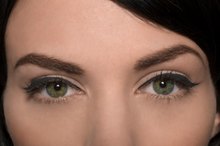The Best Colors for the Elderly
As people age, their eyes also undergo changes. The lens and cornea begin to yellow and darken, and the pupils shrink in size. The aging eye also changes to have a high degree of light scatter as cataracts form, and the field of vision becomes limited. For this reason the colors that are chosen for the elderly should remove any yellowing and brightness since the eyes of a 60-year-old can only filter a third of someone age 20.
Distinguishing Colors
Elderly persons may have difficulty distinguishing between colors. They need three times the amount of light to see, but are sensitive to glare. Colors such as red, green, yellow or blue will appear muted to the elderly eye. Colors should be used that provide a high contrast, such as white plates and a dark colored table cloth. Chair seats should contrast with the floor to make the edge of the chair more visible. The same is true for bathroom fixtures contrasting with walls and the floor so they are very visible.
- Elderly persons may have difficulty distinguishing between colors.
- Colors such as red, green, yellow or blue will appear muted to the elderly eye.
Color Choices for the Elderly
Motivational Colors for Exercising
Learn More
When people age they may experience feelings of loneliness and fearfulness. Using colors that are warm and promote security and harmony are important. When painting walls and decorating a room the colors that are used can have a positive effect on the mind and mood of elderly populations. Using a variety of colors can keep cognitive abilities functioning. Using soft blues, violets and lavender can make the elderly person connect to a spiritual or reflective mood.
- When people age they may experience feelings of loneliness and fearfulness.
- When painting walls and decorating a room the colors that are used can have a positive effect on the mind and mood of elderly populations.
Bright Colors
Using bright colors when designing for the elderly will help with acuity loss. While older people may like pastels, the colors may not be bright enough for elderly eyes 2. Softer shades of red or orange will help improve energy levels and circulation. Peach color, warm tans and apricot, terra cota and pink work well with elderly eyes. Studies done in nursing homes show that soft pinky-beiges contrasted with soft blue/greens were peaceful and emotionally supporting.
- Using bright colors when designing for the elderly will help with acuity loss.
- While older people may like pastels, the colors may not be bright enough for elderly eyes 2.
Colors Can Help Elderly Populations
Medications That Affect Color Vision
Learn More
Using floral patterns can evoke pleasant memories in elderly populations, as it will remind them of a calmer, simpler rural life.
Even the color of medications can help elderly persons remember to take them. Researchers are studying the effect of coloring the pills to the condition, for example red pills for heart medication, and a calming blue pill for pain medication. Seniors who take a lot of prescription medications can use familiar colors and shapes to keep the doses correct.
- Using floral patterns can evoke pleasant memories in elderly populations, as it will remind them of a calmer, simpler rural life.
- Even the color of medications can help elderly persons remember to take them.
Related Articles
References
Writer Bio
Bonnie Ross Coleman has been writing professionally since 2000. She has written fitness articles in "The Delaware Women's Journal," as well as a series on business plans for the National Black Guide. A Wharton School of Business graduate, Coleman has more than 20 years of experience writing proposals, marketing materials and bid documents in the corporate sector.









